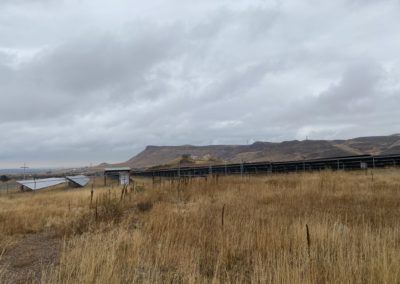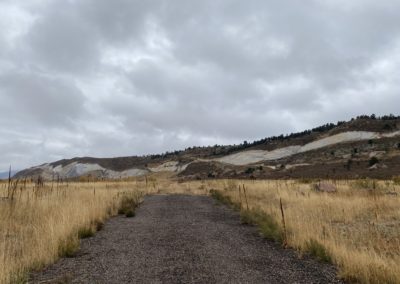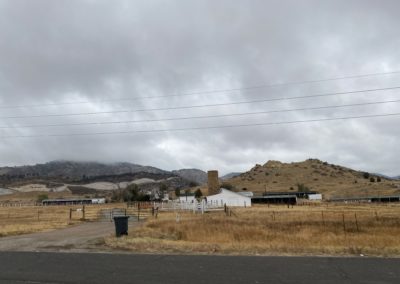City of Golden PV Evaluation
Overview
The City of Golden Photovoltaic Evaluation is a project the Golden Solar Solutions team has been assigned to in order to perform a feasibility analysis to help achieve the goal of 100% renewable energy by 2030. The scope of the project has expanded to include the entire plot designated for solar off of Highway 93 and W. 56th Ave. This allows for higher generation, but also presents new challenges for the project. These challenges include interconnection, sloped areas, possible floodplains, and increased project time. To support these aspects of the project, validation has been provided through engineering calculation and analysis and preliminary drawings.
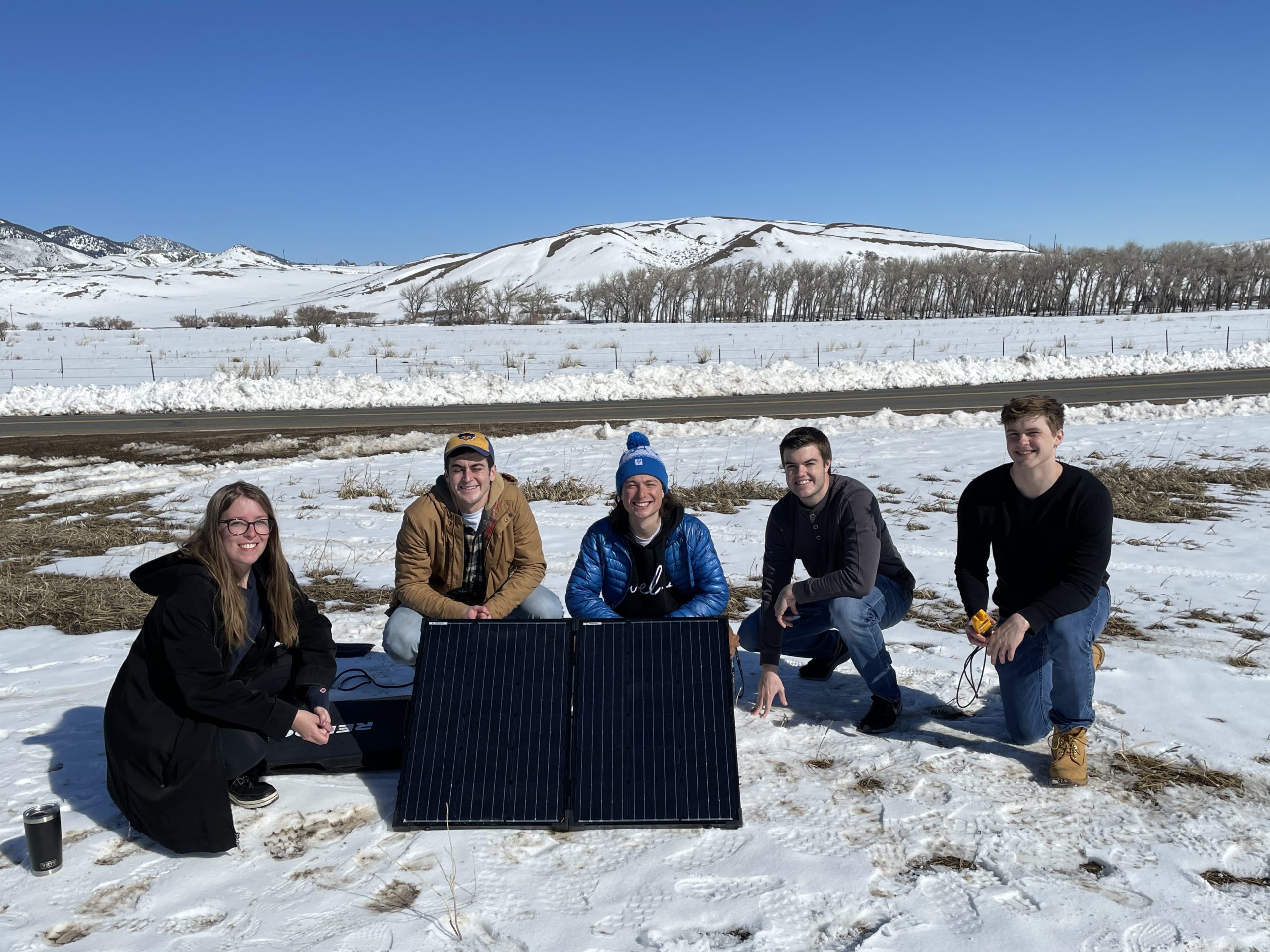
Live Zoom Chat
Use the link below to join us live from 8:00 – 10:30 a.m. on April 29th.
Please use passcode: 210322
Or iPhone one-tap: 13462487799,96948160154# or 16699006833,96948160154#
Or Telephone:
Dial: 1346248779 (US Toll) or 16699006833 (US Toll)
Meeting ID: 969 4816 0514
Team Members
- Jessica Ellis (CE)
- Daniel Morrison (ME)
- Hannah Rowan (CE)
- RJ Scavo (ME)
- William Simpson (EE)
- Zachary Simpson (EE)
The Client
- City of Golden
Acknowledgements
Client: Theresa Worsham and Marissa Major
Project Advisor: Leslie Light
Technical Advisor: Prof. Tim Ohno
Other contributors: Jill Engel-Cox from NREL and members of the Community Sustainability Advisory Board
The team approached this project by keeping two important concepts in mind which are sustainability and efficiency. While the project is renewable energy and already a sustainable approach to energy production the team took this a step further by making our components as sustainable as possible along with a focus on the effects the array will have on the environment. There is a direct correlation between sustainability and efficiency as well because more efficient products are sustainable as losses in the system are decreased.
The team focused on array efficiency by minimizing the losses in the system. While an array could have been placed on the entire plot and therefore have a much larger energy output this would have been very inefficient. On the plot of land there is a 400 foot hill on the West side referred to as a hogback. The hogback affects the production of the array during the afternoons when the sun is at its lowest in winter months. To minimize this the team did a shade analysis using Helioscope to see which panels were being shaded. Panels with 10% shading losses were removed from the array. This helped to increase the efficiency of the array. As seen in the top figure to the right, green panels experience no shading.
The team recommends going forward with a phased approach to the array to make implementation easier. The overall array was split into three separate arrays as seen to the right in the second picture. It was important to leave ample space from the current array on the land owned by Clean Energy Collective. Space was also left between each array to allow for wildlife to move through. The phased approach is broken down into the following sections.
Phase One
This section was chosen as phase one due to it being least affected by shading due to the hogback on the west side, it being easily accessible from the access road, being close to the point of interconnection with the grid, and it being among the smaller arrays so it will show the potential for solar energy on the plot.
Phase Two
This section was chosen as phase two due to its close proximity to the road. This array will also include a separate educational array that can be seen in the North most section of phase two. This educational array would be separate from the rest of phase two and allow for Golden and the surrounding areas to come and learn about solar energy.
Phase Three
Phase three is the largest array and would need an extension to the access road for installation. This array is farthest from the point of interconnection and is affected by shade on the west side but has been minimized by our array design. It also may be beneficial to split this array into two phases or two arrays. The team recommends splitting the phase three array in half with the split moving north and south.
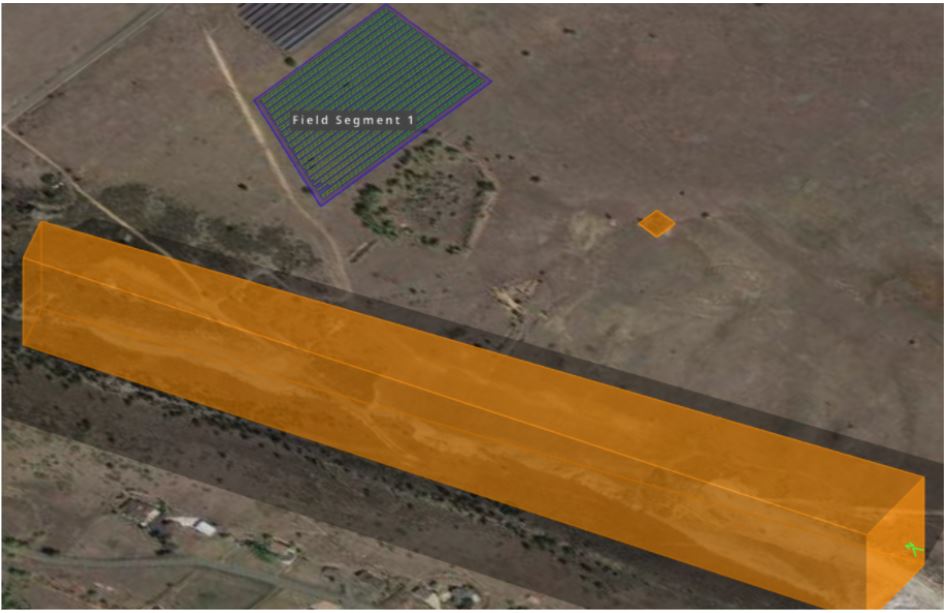
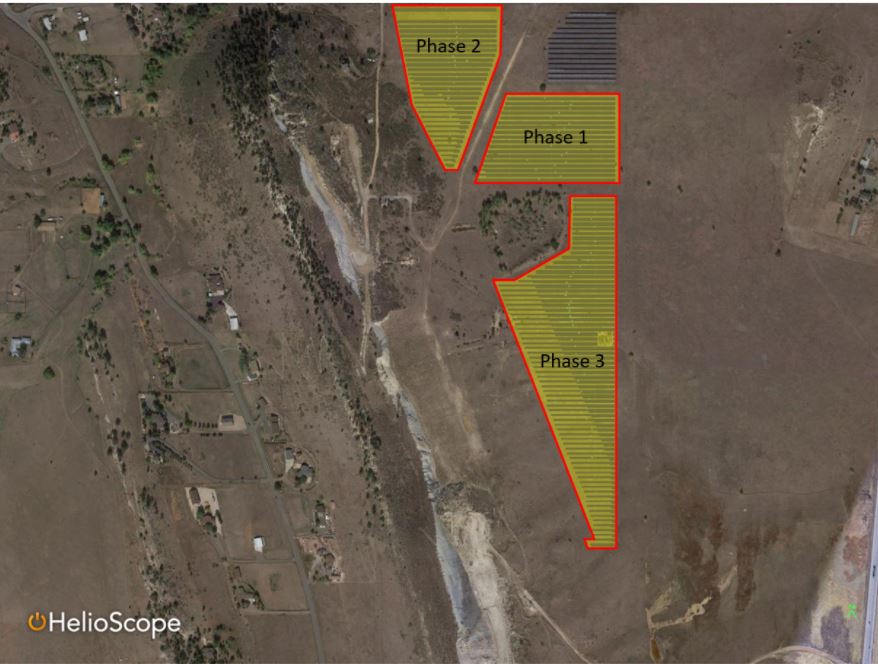
Design Solution
Array Design
The combined three phases of the array will be 12.8 MW DC. The array generates 19.5 GWh per year. The array is a fixed tilt south facing array with a tilt angle of 23 degrees. The top picture to the right shows the plot with a 15 foot setback from a fence line. There is 12 foot spacing between rows to allow for maintenance and to decrease row to row shading. For designing the array the components chosen were the Jinko 580 W split cell panel and the Delta Electronics M125HV inverter.
Civil Design:
AutoCAD Civil3D was used to draw the existing solar panel, roads, houses, and trees scattered throughout the plot. Contours from DRCOG were collected as a response to the 2013 Colorado flood, and served as a basis for land analysis. Elevations were put in for each contour and trimmed to remain inside of the property line. See the second picture on the right. From there, we were able to create a surface from the contours to provide a 3D view. The slopes vary from 2.7% to 38.9% , but for the purpose of construction the slopes could not exceed 20%. The areas in which the slopes get that steep are in a large divot which cannot be constructed due to being a floodplain. Aside from that section of the plot and the hogback, the land is feasible to work with.
Racking and Security:
APA Solutions Titan was chosen for the system’s racking because of the portrait orientation of the panels which helps to utilize the split cells of the panels. Titan meets all of Golden’s building standards.
The client was concerned about the arrays restricting animal grazing on the land. Instead of a large fence all around the plot, the team recommends a high security fence near the road with smaller fences surrounding each array. To make up for the decreased security of fencing, the team recommends security fasteners for the panels, panel locks, and motion activated lights within each array.
Interconnection:
The team went forward providing the client with a simplified way to connect with the grid focusing on two main components: the array side overcurrent protection and a transformer to connect to low voltage distribution. Our interconnection, pictured third to the right, is based on phase one but can be replicated for the rest of the phases previously discussed.
Lightning:
Lightning and thunderstorms threaten the array. Designing a suitable lightning rod array will alleviate concerns about longevity and durability. Rods will be designed to ensure they are above all panels, thus ensuring their protection along with surge protectors to ensure lightning does not damage the grid or the connection to the grid. All lightning defense companies the team has contacted have been insistent on developing after the installation of the array.
Sustainability:
Previous land sustainability options included different agrovoltaic uses like cattle and sheep grazing, bee hives, and flowers. We looked into different options of pollinator plants that can be planted year round for different conditions. These conditions include blooming season, elevation, expected weather, and sun and water needs. All of these variations are valid options for the changing seasons of Colorado.
As for recycling, the team has been researching different options. Solar panels have a lifespan of 20-30 years so their parts will need to be replaced as well as recycled. The most sustainable way to dispose of panels would be through panel recycling. Recycle PV Solar recycles panels, but they are located in Nevada. Panel recycling should be more accessible in 20-30 years.
Cost Analysis:
For cost analysis of this project we looked into the sunk and prospective costs that would affect the system. For the sunk costs we looked into the initial capital costs. These costs include the overall materials needed for the solar system such as panels, racking, wiring, etc. For some of these costs we were able to get estimates from manufactures of the parts we were working with other costs came from the NREL 2020 Q1 Solar PV system cost Benchmark report. Another included sunk cost was that of yearly maintenance and system losses. The prospective costs included the cost of energy produced in kWh a $0.08/ kWh. This also included incentive costing which consisted of a Federal ITC of 22% of the initial capital cost of the system. The capital costs can be seen in the Table pictured fourth on the right and the cash flow generated from our data can be seen in the bottom picture on the right.
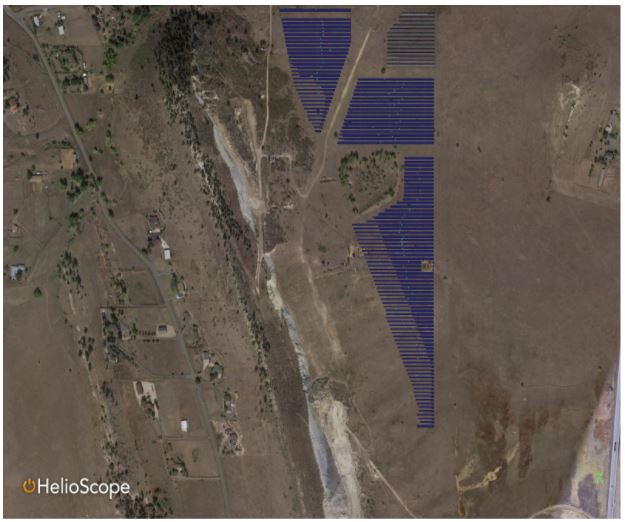

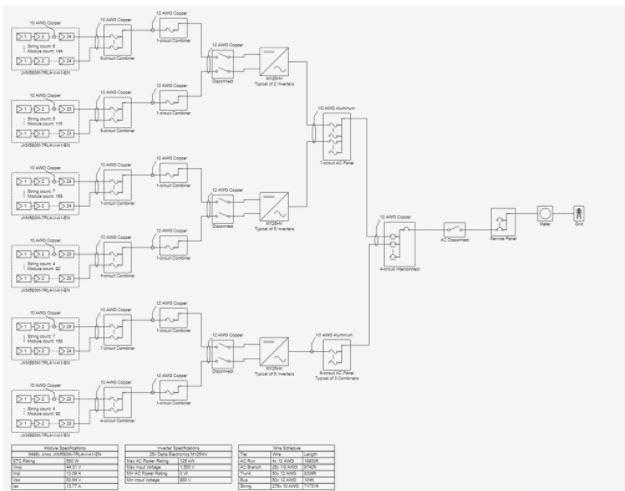
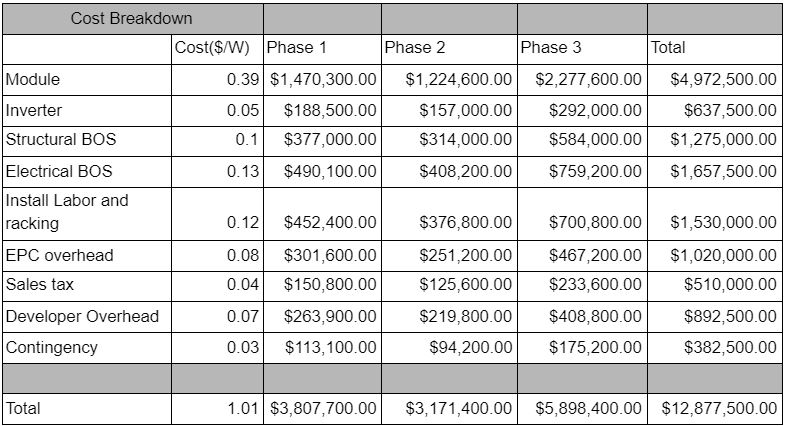
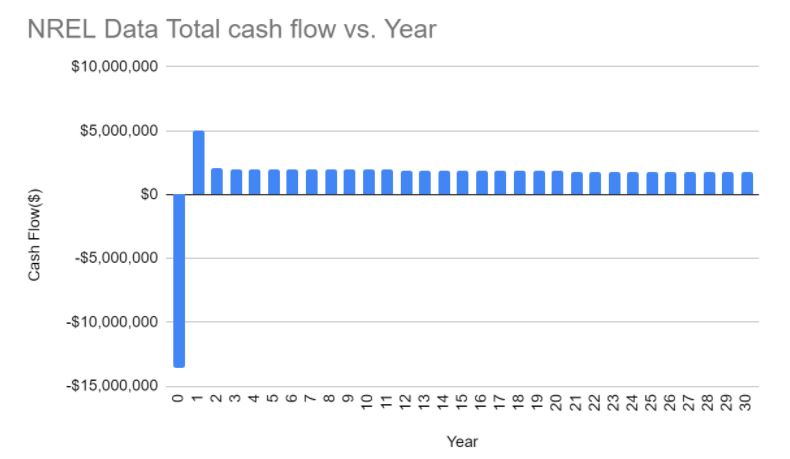
Next Steps
The team has suggested the following Next Steps should this project be worked on further
- Mechanical work
- Pathing Estimate
- The site will need paths for construction, maintenance, and monitoring of the array. This will be relatively inexpensive, but the paths need to avoid making too large of a mark on the land.
- Fencing will be a non-negligible cost because of the size of the array.
- Water Redirection and Flood Mitigation
- If flooding was mitigated, the divot could be utilized.
- Water runoff from the divot would need to be redirected.
- Pathing Estimate
- Electrical work
- Interconnection study done with Xcel to finalize interconnection plan
- Civil and environmental work
- Construction plans and further land analysis (erosion control and grading)
- Looking further into aspect of Land sustainability for this project
- Business plans
- Work with Xcel to begin developing plans for a PPA
- This PPA will give more accurate positive cash flow estimates, which would allow for a accurate financial analysis
- Work with Xcel to begin developing plans for a PPA
Meet the Team
Jessica Ellis
 Jessica Ellis is a second semester senior studying civil engineering with an emphasis on land development. She has been working on this project since August and this semester took on the role of Communication Lead. Jessica is graduating in May with a B.S. in Civil Engineering. She will be staying in Colorado after graduation to work as a project engineer for Anderson & Hastings Consultants, Inc.
Jessica Ellis is a second semester senior studying civil engineering with an emphasis on land development. She has been working on this project since August and this semester took on the role of Communication Lead. Jessica is graduating in May with a B.S. in Civil Engineering. She will be staying in Colorado after graduation to work as a project engineer for Anderson & Hastings Consultants, Inc.
Daniel Morrison
 Daniel Morrison is a senior graduating this December. He will be receiving his B.S. in Mechanical Engineering with a focus on Aerospace Engineering. He has been a part of this team for one semester. This upcoming summer Daniel will be working in a research lab at Mines studying high-velocity impacts on polymers and metals. After he graduates he hopes to go into aerospace design.
Daniel Morrison is a senior graduating this December. He will be receiving his B.S. in Mechanical Engineering with a focus on Aerospace Engineering. He has been a part of this team for one semester. This upcoming summer Daniel will be working in a research lab at Mines studying high-velocity impacts on polymers and metals. After he graduates he hopes to go into aerospace design.
RJ Scavo
 RJ Scavo is a second semester senior in the mechanical engineering program. RJ has been on the project since January, but has prior experience in solar systems from the McKinstry Mines Park Solar Feasibility Study he did in the fall of 2020. Although RJ has project experience in solar systems, his main academic focus is thermal, fluid, and energy related systems. While at Mines RJ was the president of CSM Rocket Club and an undergraduate researcher with the AMBER Research Group. RJ will be graduating in May of 2021 with a B.S. in Mechanical Engineering. He plans to pursue his master’s degree at the Colorado School of Mines in the fall.
RJ Scavo is a second semester senior in the mechanical engineering program. RJ has been on the project since January, but has prior experience in solar systems from the McKinstry Mines Park Solar Feasibility Study he did in the fall of 2020. Although RJ has project experience in solar systems, his main academic focus is thermal, fluid, and energy related systems. While at Mines RJ was the president of CSM Rocket Club and an undergraduate researcher with the AMBER Research Group. RJ will be graduating in May of 2021 with a B.S. in Mechanical Engineering. He plans to pursue his master’s degree at the Colorado School of Mines in the fall.
William Simpson
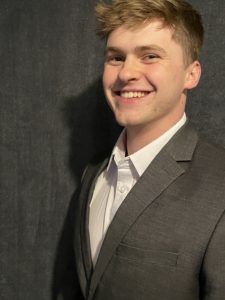 William Simpson is an electrical engineer graduating in the spring and will be receiving a B.S. in Electrical Engineering. He has been working on the solar PV project for two semesters now. He is currently employed at GLI as a test engineer working on EGM systems. William also has plans to pursue a master degree in electrical engineering sometime in the future.
William Simpson is an electrical engineer graduating in the spring and will be receiving a B.S. in Electrical Engineering. He has been working on the solar PV project for two semesters now. He is currently employed at GLI as a test engineer working on EGM systems. William also has plans to pursue a master degree in electrical engineering sometime in the future.
Zachary Simpson
 Zack is a senior graduating this May and will be receiving his B.S. in Electrical Engineering. He has been working on this project for two semesters now and has had the role of Scrum Master. Zack will be working in substation design for Black & Veatch once he graduates.
Zack is a senior graduating this May and will be receiving his B.S. in Electrical Engineering. He has been working on this project for two semesters now and has had the role of Scrum Master. Zack will be working in substation design for Black & Veatch once he graduates.


